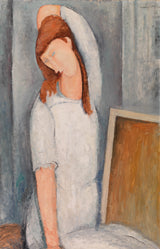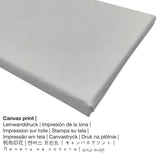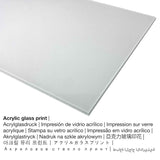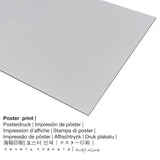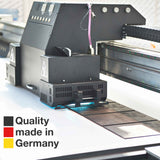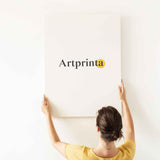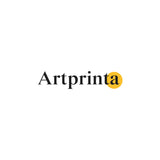Amedeo Modigliani, 1919 - Jeanne Hébuterne - mbipụta nka mara mma
Ụtụ gụnyere. Mbupu gbakọrọ na ndenye ọpụpụ.
Banyere ngwaahịa nka a
Jeanne Hébuterne was created by Amedeo Modigliani. The original measures the size: N'ozuzu: 39 1/2 x 25 3/4 na (100,3 x 65,4 cm). Oil on canvas was used by the Italian artist as the medium of the work of art. Furthermore, the work of art is in the the Ụlọ ọrụ Barnes Foundation art collection. We are happy to reference that this artwork, which belongs to the ngalaba ọha a na-enye ya site n'ikike nke Site n'ikike nke Barnes Foundation, Merion na Philadelphia, Pennsylvania.Additionally, the artwork has the following creditline: . What is more, the alignment of the digital reproduction is in Eserese usoro na oke nke 2: 3, nke pụtara na ogologo bụ 33% mkpụmkpụ karịa obosara. Amedeo Modigliani was a male painter, sculptor, whose artistic style was mainly Expressionism. The artist lived for a total of 36 afọ, born in 1884 in Livorno, Livorno province, Tuscany, Italy and died in 1920 in Paris, Ile-de-France, France.
Nweta ụdị ebipụta nka mara mma ịchọrọ
Maka akwụkwọ nka ọ bụla dị mma anyị na-enye ihe dị iche iche na nha. Họrọ n'ime nhọrọ ngwaahịa ndị a ugbu a ka ị kwekọọ na mmasị gị na nha na akụrụngwa:
- Mbipụta kanvas: The canvas direct print is a printed cotton canvas stretched on a wood frame. How do I hang a canvas on my wall? The advantage of canvas prints is that they are relatively low in weight, meaning that it is easy to hang up the Canvas print without additional wall-mounts. Hence, canvas prints are suitable for all kinds of walls.
- Poster (akwa akwa akwa): The poster print is a printed canvas paper with a slightly roughened surface finish. Please keep in mind, that depending on the absolute size of the poster print we add a white margin 2-6cm round about the artwork, which facilitates the framing with your custom frame.
- Mbipụta ọla (aluminium dibbond): Aluminium Dibond prints are prints on metal with a true effect of depth. The non-reflective surface creates a contemporary impression. For the Direct Print On Aluminum Dibond, we print the selected work of art onto the aluminium composite surface. The bright & white parts of the original work of art shimmer with a silk gloss, however without any glare. The colors are luminous, the fine details of the print appear very clear, and the print has a a matte look that you can literally feel. This direct UV print on Aluminum Dibond is the most popular entry-level product and is a stylish way to display art prints, as it draws focus on the replica of the artwork.
- Mbipụta iko acrylic (nke nwere ezigbo mkpuchi iko): The print on acrylic glass, often referenced as a plexiglass print, changes the original into wonderful home decoration. Additionally, the acrylic glass art print is a good alternative to canvas and dibond prints. The artwork is being made with the help of modern UV direct print machines. This makes vivid, impressive color tones. The great upside of an acrylic glass fine art copy is that contrasts plus artwork details become visible with the help of the very subtle gradation in the picture. The plexiglass protects your chosen art print against light and external influences for many years to come.
Ederede iwu dị mkpa: We try to describe our products as clearly as possible and to illustrate them visually. Although, the colors of the printing material and the print result can vary slightly from the image on the device's monitor. Depending on the settings of your screen and the nature of the surface, not all color pigments can be printed one hundret percent realistically. In view of the fact that all art reproductions are processed and printed manually, there might also be slight deviations in the size and exact position of the motif.
Nkọwa ihe ahaziri ahazi
| Nkewa ngwaahịa: | mmepụta nka |
| Usoro mmeputakwa: | mmeputakwa n'ụdị dijitalụ |
| Production usoro: | UV kpọmkwem obibi |
| Production: | Germany |
| Ụdị ngwaahịa: | a na-achọ |
| Ojiji ngwaahịa: | ịchọ mma mgbidi, ihe ndozi mgbidi |
| Ndepụta: | usoro eserese |
| Njikwa oyiyi: | 2: 3 ogologo ruo obosara |
| Pụtara nke akụkụ akụkụ: | ogologo bụ 33% mkpụmkpụ karịa obosara |
| Ụdị akwa: | akwụkwọ mmado (akwụkwọ kwaaji), mbipụta ọla (aluminium dibond), mbipụta kanvas, mbipụta iko acrylic (nwere ezigbo mkpuchi iko) |
| Nha n'arọwa n'elu ihe ndọtị (mbipụta akwa akwa): | 20x30cm - 8x12", 40x60cm - 16x24", 60x90cm - 24x35", 80x120cm - 31x47", 100x150cm - 39x59" |
| Mpempe iko acrylic (nwere ezigbo mkpuchi iko) nha: | 20x30cm - 8x12", 40x60cm - 16x24", 60x90cm - 24x35", 80x120cm - 31x47", 100x150cm - 39x59" |
| Nhọrọ nke mbipụta akwụkwọ mmado (akwụkwọ kwaaji): | 40x60cm - 16x24", 60x90cm - 24x35", 80x120cm - 31x47" |
| Mpempe akwụkwọ Dibọn (ihe alumnium): | 20x30cm - 8x12", 40x60cm - 16x24", 60x90cm - 24x35", 80x120cm - 31x47" |
| Nhazi nke nka nka: | enweghị etiti |
Ozi ndabere gbasara ọrụ nka mbụ
| Aha ọrụ nka: | "Jeanne Hébuterne" |
| Nchịkọta nke ọrụ nka: | sere |
| Otu sara mbara: | nkà nke oge a |
| Nhazi oge: | 20th narị afọ |
| Emepụtara n'afọ: | 1919 |
| Afọ nka: | ihe dị ka afọ 100 |
| Agba na: | mmanụ na kwaaji |
| Akụkụ izizi (ọrụ nka): | N'ozuzu: 39 1/2 x 25 3/4 na (100,3 x 65,4 cm) |
| Ụlọ ihe ngosi nka / ebe: | Ntọala Barnes |
| Ebe ngosi nka: | Philadelphia, Pennsylvania, Njikota Obodo Amerika |
| Dị n'okpuru: | Ntọala Barnes |
| License: | ngalaba ọha |
| Site n'aka: | Site n'ikike nke Barnes Foundation, Merion na Philadelphia, Pennsylvania |
Nkọwa onye nka
| Ihe nkiri: | Amedeo Modigliani |
| Aha ndi ozo: | מודילאני אמאדאו, Modigliani Amedeo Clemente, Modigliani, Modilʹi︠a︡ni Amedeo, amadeo modigliani, Modiljani Amedeo, Mo-ti-liang-ni, מודיליאני אמדיאו, Modigliani Amedeo, Modigliani A., a. modigliani, Mūdilyānī Amīdivū, Amedeo Modigliani, Modigliani Amadeo |
| okike nke onye nka: | nwoke |
| Nationality: | Italian |
| Ọrụ: | onye na-akpụ ihe, onye na-ese ihe |
| Country: | Italy |
| nhazi ọkwa: | omenkà nke oge a |
| Ụdị nka: | Nkwupụta |
| Nwụrụ na afọ nke: | 36 afọ |
| Amụrụ n'afọ: | 1884 |
| Amụrụ na (ebe): | Livorno, mpaghara Livorno, Tuscany, Italy |
| Nwuru: | 1920 |
| Obodo ọnwụ: | Paris, Ile-de-France, France |
© echekwabara ikike nwebiisinka, Artprinta (www.artprinta.com)
Artwork specifications as provided by Barnes Foundation (© Nwebiisinka - site na Barnes Foundation - Ntọala Barnes)
The model here is Jeanne Hébuterne, Amedeo Modigliani's lover during the last three years of his life. Hébuterne was an art student when she and Modigliani began their relationship in 1917. The two lived together in the Montparnasse neighborhood of Paris, and she frequently posed for him. Though their relationship was often stormy, the turmoil never found its way into his paintings; instead, Modigliani presents his lover as the embodiment of calmness and sensuality, drawing inspiration from ancient Greek statuary and African tribal sculpture.

